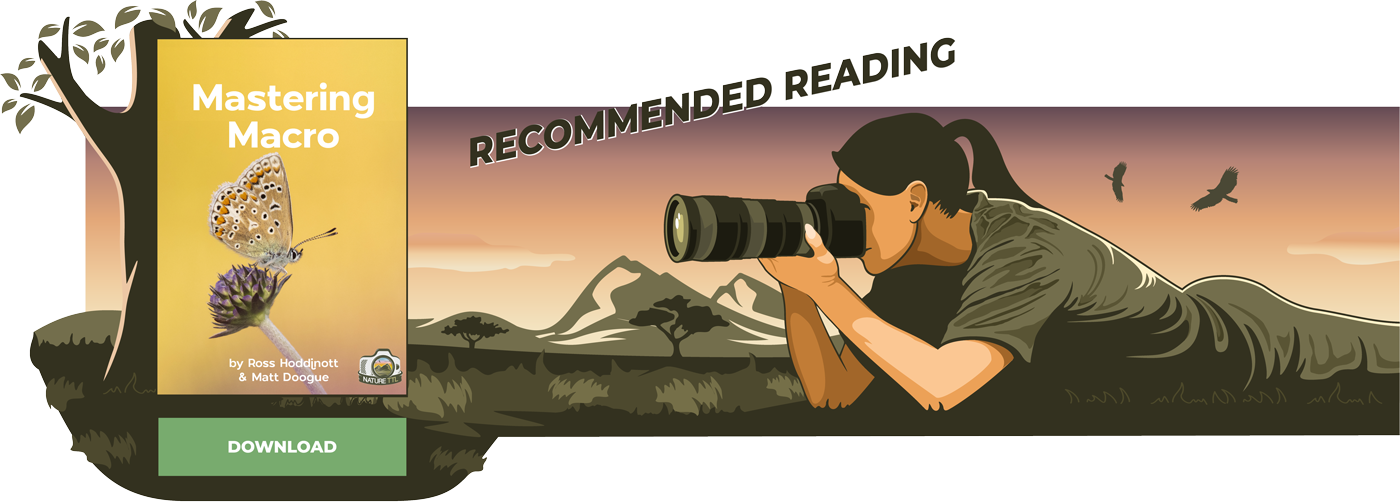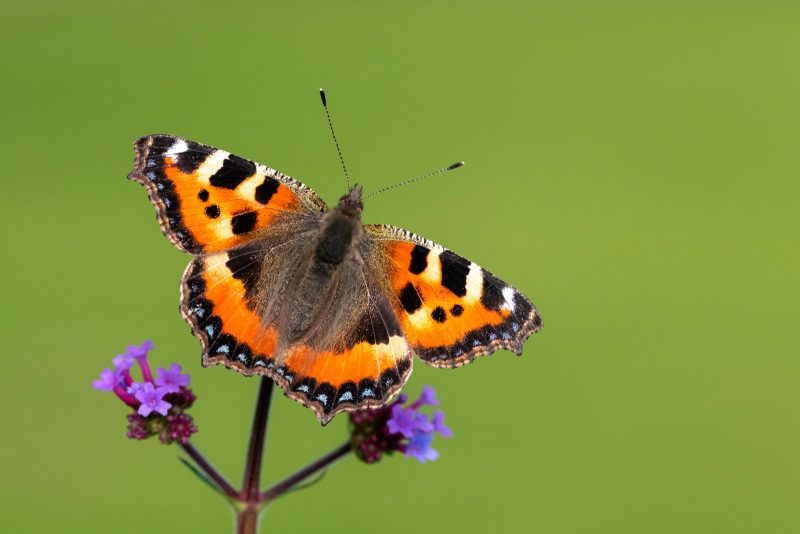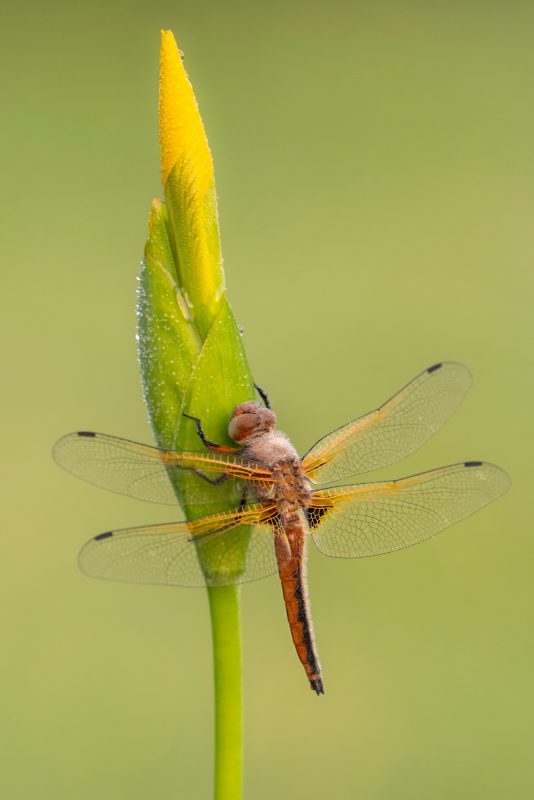A Guide to Garden Macro Photography

The Covid pandemic has been challenging for everyone. It’s affected our physical and mental health, finances and stability. But there have been positives too. Not being able to travel freely has made many of us re-evaluate and appreciate what we have on our doorstep. Our gardens – big or small – have been a lifeline for many, providing breathing space and an opportunity to be outdoors and connect with nature.


For wildlife photographers, gardens have always been a great resource, but now more than ever we should recognise and value the vast photo opportunities that await us in our very own backyards.
For close-up photographers in particular, a garden habitat harbours so many photographic subjects. I’ve always been a big fan of working close to home. In addition to the obvious environmental benefits to traveling less, it is easier to adapt your photography around family or work commitments when taking photos in your own garden – and you can be more spontaneous too.
You can also take photos without risk of disturbance, while having more time and opportunity to ‘play’ and be innovative with your photography.
So, how well do you know your garden? Get on your hands and knees and look closely – and then look closer again. You will soon discover busy bees, hoverflies, and butterflies visiting garden flowers and blossom.
If you have a pond, expect dragonflies and damselflies to patrol the skies. Meanwhile, look among tall grasses and foliage to discover caterpillars, moths, shield bugs, lacewings, and ladybirds.
Spiders will decorate hedges and sheds with intricate webs, while under rocks and flowerpots you will discover woodlice and other mini beasts.
Quite simply, rural and urban gardens are an essential habitat and important gateway for many little creatures. To help you unlock the great photo potential of your garden, simply read on…
Make your garden wildlife friendly
By making your garden more wildlife friendly, you will not only benefit nature, but your photography too. There are numerous things you can do to help and encourage wildlife.
Start by not being too tidy. For example, leave a small area of lawn uncut – longer grass is important for insects. Avoid using pesticides and, if possible, create wood and leaf piles for little critters to shelter and feed – or create or buy a purpose made bug hotel.
Fill borders with flowering plants and shrubs that will provide nectar – lavender, buddleia, honeysuckle, sunflowers and cosmos will not only attract insects, but they are colourful and photogenic too. Think carefully about where you plant flowers – try to site them in positions where they will receive good light throughout the day. Consider their background too – the more thought you put in at the planting stage, the easier it will be to take good macro shots later.
Read more: How to Attract Insects to Your Garden for Photography
Photographing garden invertebrates
One of the great appeals of close-up photography is that you don’t need to travel further than your own backyard to discover fabulous and photogenic miniature subjects. You don’t necessarily need expensive kit either.
Your garden is a great place to hone your close-up skills. One of the easiest garden subjects to find and photograph are snails. They might not be considered the most glamorous creatures but, being slow moving, they are ideal subjects for macro beginners.
Although I always discourage photographers from ever moving or handling subjects, snails are easy to move without risk of damage and doing so will allow you to place them in a position better suited to photography. However, always handle them with care and quickly return them to where they were found.
Moving your subject allows you to control the look and feel of your shot. For example, when photographing snails, try using suitable props in order to place your subject in context with its garden environment – a flowerpot, milk bottle, or garden trowel maybe. Create your set-up on a garden table or bench in order to allow you to take photos from a more comfortable height. Consider using a small LED device to alter or enhance the light – or even take photos at twilight, using outdoor lighting to create striking night-time shots.
Spring and summer are the best times of year to photograph close-ups of insects in your garden. Assuming you have flowerbeds and potted plants, your garden should be full of colour and activity. Colourful blooms make a great backdrop for ladybirds, beetles, and shield-bugs, so search flower heads for subjects and fill the frame for maximum impact.
An overhead angle often works well when taking photos of insects basking or feeding on flowers. Bees and hoverflies love lavender and other nectar rich blooms and will often return again and again to the same plant.
Getting close to insects for photos
Rather than chase insects about, it is often better to wait for them to come to you. Identify a flower in pristine condition, in a well-lit position that also provides a clean backdrop. Set up your tripod, compose your shot, adjust your settings, and pre-focus. Now, get comfortable and wait.
Butterflies, bumblebees, and honeybees will come back and forth to feed. Select continuous shooting mode and a fast shutter speed, and take a burst of shots as your subject enters and exits the frame. A low ratio of success is inevitable when photographing small, fast moving subjects but, with patience, you will achieve good results and maybe capture some in-flight shots too.
Read more: How to Photograph Insects in Flight
Weather conditions
Working close to home allows you to react quickly to sudden or unexpected changes in the light or weather. For example, after a rain shower, pop out into your garden and look for insects sheltering under leaves and flowers.
Generally speaking, early morning is often the best time of day to photograph insects, when they are cool, inactive and potentially glistening with dew. There is no excuse not to get up early when you don’t need to walk any further than your own garden!
Low morning sunlight is soft and warm, but garden fences and nearby houses may obstruct the best light – so be prepared to use flash or a small LED light to supplement natural sunlight.
Look carefully and assiduously among grasses, flowers and under leaves for roosting, dormant subjects. Having found a suitable model, you should be able to take photographs with relative ease – until the temperature rises, most insects will remain inactive and still.
Most gardens are quite sheltered, so wind movement is often less of a problem, but use a tripod so that you can compose and focus your shots precisely or consider creating a focus stack to extend depth of field.
Food sources
If you grow vegetables or fruit in your garden, this will also entice wildlife. For example, in early autumn, fruit and windfall apples will attract wasps and butterflies and provide great opportunities to get close-up.
We have a little orchard where I live and, this past autumn, I collected a handful of apples and piled them up on our lawn. I then just sat next to the fruit with my camera and macro lens at the ready. Within minutes, red admirals, commas, and wasps were visiting to feed and appeared completely oblivious to me snapping away. Your garden can be an endless source of photo opportunities…
Pondlife
Water will always attract wildlife. Even a small garden pond or water feature will entice pond skaters, damselflies, and dragonflies.
If you don’t already have one, consider building a small pond – it is a great lockdown or weekend project to give yourself. Visit a local garden centre and purchase a preformed pond, made from durable plastic, and sink it into the ground – or use a heavy-duty membrane that cannot be easily pierced or damaged. Ideally, allow your pond to fill naturally with rainwater. Add native aquatic plants, reeds, and lilies to create cover for amphibians and larvae.
Dragonflies and damselflies are amongst our most beautiful garden visitors – and a personal favourite of mine. Dragonflies may visit gardens to hunt, even if you don’t have a pond, but water will maximise your chances of photographing them in your backyard.
During daytime, dragonflies will be busy and dart about but, being territorial, you may notice them returning to the same perch again and again.
Once you have identified a favoured resting place, stay close by with your camera ready to move into position. Damselflies are smaller and will land more regularly on nearby plants or lily pads.
It is best to approach slowly and avoid any sudden movements. Be careful not cast your shadow across the subject as doing so will alert it.
Ensure your focus is sharply on your subject’s disproportionately large eyes and try to keep backgrounds free of clutter and distraction.
Read more: Macro Photography – How to Take Handheld Photos of Insects
If you do have a pond, expect frogs and toads to spawn in late winter/early spring. This is a great opportunity to get photos, with subjects preoccupied with finding a mate and therefore easier to get close to.
Try kneeling by the edge of your pond and wait for individuals, or mating pairs, to poke their heads above the water’s surface to breath. At other times of the year, you are more likely to find frogs and toads sheltering among long damp grasses, or among wood piles during daytime, but they are just as photogenic on land as they are in the water.
An eye-level viewpoint will often produce the most intimate and natural shots, so be prepared to lay prone on the ground to get the best results.
Garden plants
Few subjects offer a more varied choice of colour or design than flowers. Big or small, most gardens are home to colourful blooms and blossom just crying out to be photographed in close-up.
While I prefer photographing wildflowers, cultivated blooms like sunflowers, gerberas, dahlias, tulips, and cosmos are all particularly photogenic. Spring until early autumn is normally the best time for blooms and blossom.
When taking photos outdoors, opt for a still day or find a sheltered corner of your garden – wind movement appears greatly exaggerated at higher magnifications and will make it tricky for you to frame and focus your shot. Alternatively, use a clamp or Wimberley Plamp to stabilise stems.
Pristine blooms will look best under the scrutiny of a close focusing lens. Also avoid harsh, direct sunlight – diffused light will help your camera record colour and fine detail accurately. So, on sunny days, use a diffuser or your own shadow to eliminate contrast.
Water droplets will add interest, scale and sparkle to flower close-ups. Either take photos after rainfall or spray your subject with an atomiser or garden spray. You could even try to capture the refracted image of a flower in a water droplet.
Background choice
Think carefully about background choice. You should aim to avoid messy, distracting backdrops, but in a tight-knit garden it can be tricky to place any distance between your subject and its surroundings.
Backyards tend be a busy, chaotic mix of lawn, flowerbeds, garden furniture, and other distractions. One effective way to exclude or disguise these things is to opt for a large aperture. An f-number in the region of f/2.8 or f/4 will generate a shallow depth of field and diffuse background clutter.
You can create very arty, painterly results using a shallow zone of focus, and also highlight key points of interest like a flower’s stamens or an individual petal. However, remember that working with such a narrow zone of focus means your focusing has to be pinpoint accurate.
In conclusion
So, there you have it. Working in your garden encourages experimentation and innovation and if, once you’ve downloaded your shots, you find your first attempts haven’t worked as well as you had hoped, it should be easy enough to set-up and try again.
Gardens are a rich habitat and valuable resource for macro photographers. And you certainly don’t have to be in lockdown to appreciate, or to harness, the photo potential of your own backyard.



















